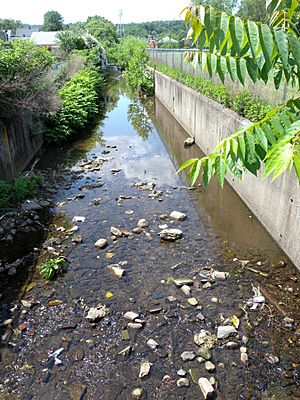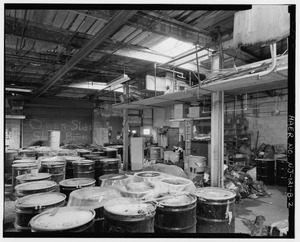United States Radium Corporation facts for kids
|
Formerly
|
Radium Luminous Material Corporation |
|---|---|
| Private | |
| Fate | Merger |
| Founded | 1914 in New York City, New York |
| Founders | Dr. Sabin Arnold von Sochocky Dr. George S. Willis |
| Defunct | May 1970 |
| Headquarters |
United States
|
| Products | Glow-in-the-dark radioactive paint |
| Superfund site | |
| Geography | |
| City | Orange |
| County | Essex County |
| State | New Jersey |
| Information | |
| CERCLIS ID | NJD980654172 |
| Contaminants | Cadmium, Radium-228, radon, radionuclide, Thorium-230, Thorium-232, Uranium-234, Uranium-235, Uranium-238, Vanadium(V) oxide |
| Progress | |
| Listed | 1983 |
| Construction completed |
September 28, 2006 |
| List of Superfund sites | |
The United States Radium Corporation was a company that made glow-in-the-dark paint. It was most famous for its work between 1917 and 1926 in Orange, New Jersey. The company's actions led to much stronger laws to protect workers.
After making a successful glow-in-the-dark paint, the company faced many lawsuits. This happened in the late 1920s because workers became very sick or died. These workers, known as the Radium Girls, had swallowed radioactive material. The company had told them the paint was safe. During World War I and World War II, the company made glowing watches and gauges for the United States Army.
Workers at U.S. Radium, especially women who painted dials, suffered from serious exposure to radioactive material. A lawyer named Edward Markley defended the company in these legal cases.
Contents
History of the Radium Corporation
The company started in 1914 in New York City. It was founded by Dr. Sabin Arnold von Sochocky and Dr. George S. Willis. Its first name was the Radium Luminous Material Corporation.
The company first produced uranium from a type of rock called carnotite. Later, it began making glow-in-the-dark paint and applying it to products. Over the next few years, it opened factories in Newark, Jersey City, and Orange. In 1921, Dr. von Sochocky was no longer the president. The company was then renamed the United States Radium Corporation.
In Orange, radium was taken out of ore from 1917 to 1926. The U.S. Radium factory processed about half a ton of ore every day. This ore came from mines in Paradox Valley, Colorado and Utah. A famous employee from 1921 to 1923 was Victor Francis Hess. He later won the Nobel Prize in Physics.
The Undark Paint and Its Dangers
The company's glow-in-the-dark paint was called Undark. It was a mix of radium and zinc sulfide. The radium's radiation made the sulfide glow. During World War I, there was a huge demand for dials, watches, and aircraft instruments painted with Undark. The company grew a lot to meet this demand.
Young women mostly did the careful job of painting watch and gauge faces. They were told to keep a fine point on their paintbrushes by licking them. At that time, people did not fully understand how dangerous radiation was. Around 1920, another company, Radium Dial Company, also painted dials. It moved its operations to Ottawa, Illinois. Several workers there also died. Even though the health risks were known, this company kept painting dials until 1940.
The managers and scientists at U.S. Radium took safety steps. They used masks, gloves, and screens. But they did not give these safety items to the workers. The women did not know the paint was highly radioactive and could cause cancer.
Swallowing the paint, by licking the brushes, led to a condition called radium jaw. This was a painful swelling and weakening of the jawbones. It eventually caused many of the women to die. This led to lawsuits against U.S. Radium by the Radium Girls. The first case was brought by Marguerite Carlough in 1925. This case was settled in 1926. More lawsuits followed in 1927 by Grace Fryer and Katherine Schaub. The company did not stop hand-painting dials until 1947.
Company Changes Over Time
The company faced challenges after World War I. Military contracts ended, which greatly reduced the need for glow-in-the-dark paint. In 1922, new, high-quality ore was found in Katanga. This caused all U.S. suppliers to go out of business except U.S. Radium.
U.S. Radium moved its main operations to Manhattan in 1927. It rented out the Orange factory and sold other properties. But demand for glowing products rose again during World War II. By 1942, it had about 1,000 workers. In 1944, it had facilities in Bloomsburg, Pennsylvania; Bernardsville, New Jersey; Whippany, New Jersey; and North Hollywood, California.
After World War II, the company downsized again. Military contracts ended, and new materials like promethium-147 and tritium were used for luminous dials. Also, radium mining in Canada stopped in 1954, making radium more expensive. In 1954, the company combined its operations in Morristown, New Jersey and South Centre Township, near Bloomsburg, Pennsylvania.
In Bloomsburg, it kept making items with glow-in-the-dark paint. These used radium, strontium-90, and cesium-137. Products included watch dials, instrument gauges, and paint. The company stopped processing radium completely in 1968. It spun off those operations into a new company. The next year, a new part of the Bloomsburg plant opened. It focused on making glow-in-the-dark exit and aircraft signs using tritium.
Starting in 1979, the company changed a lot. A new company, Metreal, Inc., was created. It held the assets of the Bloomsburg plant. Manufacturing then moved into new smaller companies. These included Safety Light Corporation and USR Lighting. Finally, in 1980, U.S. Radium created a new holding company called USR Industries, Inc. U.S. Radium then merged into this new company.
The Safety Light Corporation was sold to its managers in 1982. It became an independent company. Its tritium-lit signs were sold under the name Isolite.
In 2005, the Nuclear Regulatory Commission did not renew the licenses for the Bloomsburg facility. Soon after, the EPA added the Bloomsburg facility to a list for cleanup. All tritium operations at the plant stopped by the end of 2007.
Impact and Cleanup
The chief medical examiner of Essex County, New Jersey, Dr. Harrison Stanford Martland, published a report in 1925. He found that the radioactive material the women had swallowed caused their bone disease and aplastic anemia. This ultimately led to their deaths.
The illnesses and deaths from swallowing radium paint led to lawsuits. These lawsuits forced the company to close its Orange factory in 1927. The cases were settled out of court in 1928. However, many of the women were already very sick or had died from bone cancer and other radiation-related illnesses. People claimed the company purposely delayed settling the lawsuits. This delay led to more deaths.
In November 1928, Dr. von Sochocky, who invented the radium paint, died. He suffered from aplastic anemia because he was exposed to the radioactive material. He was called "a victim of his own invention." The victims were so contaminated that radiation can still be found at their graves. A Geiger counter can detect it.

Superfund Site Cleanup
While operating, the company processed about 1,000 pounds of ore daily. This waste was dumped at the factory site. The radon gas and radiation from 1,600 tons of material at the abandoned factory made it a Superfund site. The United States Environmental Protection Agency (EPA) named it a Superfund site in 1983.
From 1997 to 2005, the EPA cleaned up the site. This involved digging up and removing radium-contaminated material. They cleaned the former plant site and 250 homes and businesses that had been contaminated. In 2009, the EPA finished its long Superfund cleanup effort.
See also
 In Spanish: United States Radium Corporation para niños
In Spanish: United States Radium Corporation para niños


